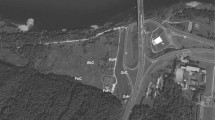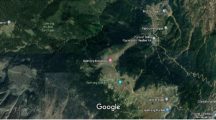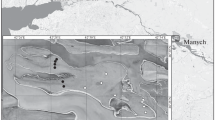Abstract
Soil nematode communities were investigated in the Changbai Mountain in Broad-leaved Korean Pine forest, Korean Pine and spruce-fix mixed forest, Dark Coniferous forest, Erman’s birch forest and Alpine tundra along different altitude gradients from 762 m to 2 200 m a.s.l. Soil animal samples were collected from the litter layer and the soil depth of 0–5 cm, 5–10 cm and 10–20 cm at each site in the spring of 2001 and 2002. In total 27 nematode families and 60 genera were observed. The dominant genera were Plectus Bastian and Tylenchus Bastian and most of them live in litter layer. The total number of soil nematode was significantly correlated with soil moisture (r=0.357; p<0.01). Nematodes were classified in bacterivores, fungivores, plant parasites, omnivores-predators, and omnivores according to known feeding habitats or stoma and esophageal morphology. Species richness of fungivorous nematode was higher than others in different vegetation communities and soil depths. The total number of soil nematode and trophic groups varied significantly (p<0.05) in response to different soil depths. The fungivore/bacterivore ratio (F/B) and the ratio of (fungivores + bacterivores)/plant-parasites (WI) also changed significantly (p<0.05) in different soil depths. In conclusion, soil moisture is proved to be one of the most important variables affecting nematode density and trophic composition, and the altitude gradient does not significantly affect the ecological indices of soil nematode such as trophic diversity (TD) and the Shannon index (H′).
Similar content being viewed by others
References
Bongers T. 1990. The maturity index: An ecological measure of environmental disturbance based on nematode species composition. Oecologia, 83: 14–19.
Coleman JS, Bazzaz FA. 1992. Effects of CO2 and temperature on growth and resource use of co-occurring C3 and C4 annuals. Ecology, 73: 1244–1259.
Conway TJ, Tans P, Waterman LS, Thoning, KW. 1998. Atmospheric carbon dioxide measurements in the remote global troposphere 1981–1984. Tellus 40B: 81–115.
Ettema CH, Bongers T. 1993. Characterization of nematode colonization and succession in disturbed soil using the Maturity Index. Biology and Fertility of Soils. 16: 79–85.
Fisher FM, Parker LW, Anderson J P, Whitford WG. 1987. Nitrogen mineralization in a desert soil: Interacting effects of soil moisture and nitrogen fertilizer. Soil Science Society of America Journal, 51: 1033–1041.
Freckman DW, Ettema CH. 1993. Assessing nematode communities in agroecosystems of varying human intervention. Agriculture Ecosystems & Environment, 45: 239–261.
Hansen JE, Lacis A, Rind D, Russel L, Stone P, Fung I, Riedy R, Lerner J. 1984. Climate processes and climate sensitivity. Geophysical Monograph Series, 29: 130–163.
Heip C, Herman PMJ, Soetaert K. 1988. Data processing, evaluation and analysis. In: Higgins, R. P. and Thiel, H. (eds.), Introduction to the Study of Meiofauna. Washington. D. C.: Smithsonian Institute Press, pp. 197–231.
Liliana R. 2003. Nematode soil faunal analysis of decomposition pathways in different ecosystems. Nematology, 5(2): 179–181.
Mooney HA. 1991. Biological response to climate change: An agenda for research. Ecological Applications, 1: 112–117.
Porazinka DL, Coleman DC. 1995. Ecology of nematodes under influence of Cucurbita spp. and different fertilizer types. Journal of nematology, 27: 617–623.
Sohlenius B, Sandor A. 1987. Vertical distribution of nematodes in arable soil under grass (Festuca pratensis) and barley (Hordeum distichum). Biology and Fertility of Soils, 3: 19–25.
Steinberger Y, Liang Wenju. 2000. Nematode community composition and diversity associated with a topoclimatic transect in a rain shadow desert. XIII International Colloquium on Soil Zoology. Czech Republic, 14–18 August.
Steinberger Y, Liang Wenju, Savkina E, Meshi T, Barness G. 2001. Nematode community composition and diversity associated with a topoclimatic transect in a rain shadow desert. European Journal of Soil Biology, 37: 315–320.
Steinberger Y, Loboda I, Garner W. 1989. The influence of autumn dewfall on spatial and temporal distribution of nematodes in the desert ecosystem. Journal of Arid Environments, 16: 177–183.
Steinberger Y, Sarig S. 1993. Response by soil nematoda populations and the soil microbial biomass to a rain episode in the hot, dry Negev desert. Biology and Fertility of Soils, 16: 188–192.
Twinn DC. 1974. Nematodes. In: Dickinson, C. H. and Pugh, G. J. F. (eds.), Biology of Plant Litter Decomposition. London: Academic Press, pp. 421–465.
Wasilewska L. 1994. The effect of age of meadows on succession and diversity in soil nematode communities. Pedobiologia, 38: 1–11.
Whitford WG. 1986. Pattern in desert ecosystem: Water availability and nutrient interactions. In: Dubinsky, Z. and Steinberger, Y. (eds.), Environmental Quality and Ecosystem Stability. Ramat Gan: Bar-Ilan University Press, pp. 109–117.
Wu Gang, Xiao Han, Zhao Jingzhu, Shao Guofan. 2001. Changbai Mountain’s forest ecosystem services. Science in China (Series C), 31(5): 471–480. (in Chinese)
Yeates GW. 1987. How plants affect nematodes. Adv Ecol Res, 17: 61–113.
Yeates GW. 1994. Modification and qualification of the nematode maturity index. Pedobiologia, 38: 97–101.
Yeates GW, Bongers T, De Goede RGM, Freckman D, Georgieva SS. 1993. Feeding habits in soil nematode families and genera-an outline for soil ecologists. Journal of Nematology, 25: 315–331.
Yin Wenying. 2000. Soil animals of China (in Chinese). Beijing: Science Press, p149–182.
Yin Xiuqin. 2001. Study on Forest Soil Animals in the Northeast of China. Changchun: Northeast Normal University Press, p54–80.(in Chinese)
Author information
Authors and Affiliations
Corresponding author
Additional information
Foundation project: This study was funded by the National Science Foundation of China and project (Grant No.G1999043407) supported by the National Key Basic Research Special Funds (Nos. 30170744 and G1999043407).
Rights and permissions
About this article
Cite this article
Tong, Fc., Xiao, Yh. & Wang, Ql. Soil nematode community structure on the northern slope of Changbai Mountain, Northeast China. Journal of Forestry Research 21, 93–98 (2010). https://doi.org/10.1007/s11676-010-0016-0
Received:
Accepted:
Published:
Issue Date:
DOI: https://doi.org/10.1007/s11676-010-0016-0




